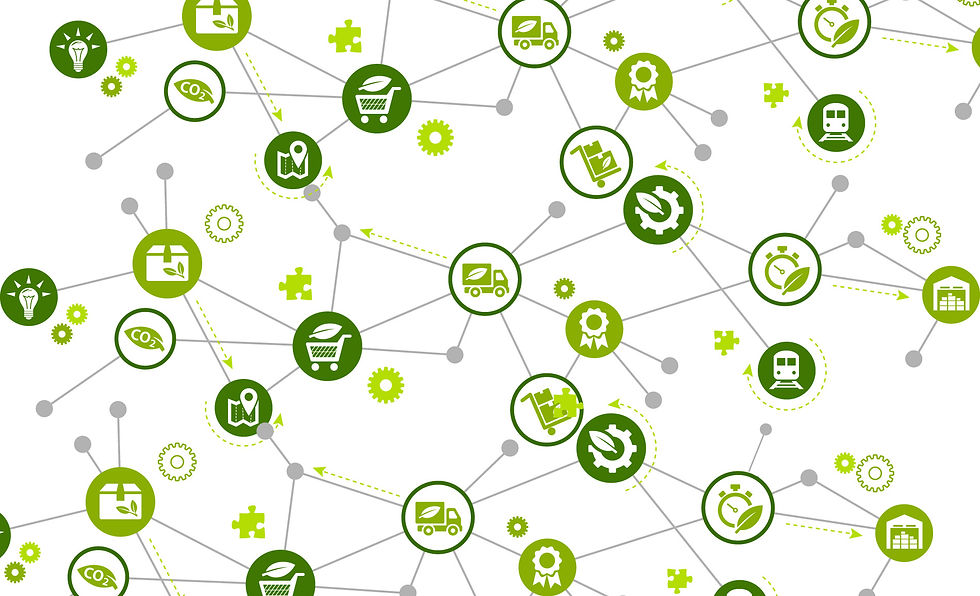Green Supply Chains
- Eirini Sampson

- Feb 15, 2022
- 4 min read
In the wake of the global pandemic in 2020, many people all over the world began their move to becoming environmentally conscious in terms of the products they are consuming. The pandemic not only spurred an emotional turmoil, but it also opened our eyes to the wrath of nature when human beings start taking it for granted. It has also affected businesses and disrupted their supply chain processes.

Photos © Edward Burtynsky, courtesy Howard Greenberg Gallery and Bryce Wolkowitz Gallery, New York / Nicholas Metivier Gallery, Toronto
As we have previously discussed, the shift in sustainable practises reflected the poor social infrastructures within corporate supply chains. The pandemic shed light on the importance for improved sustainability practises that would retain talent, prioritise the health and safety of its employees, as well as engage with vulnerable communities. In addition to this, the brief breath that our Earth took once there was a global lockdown showed the rapid ways that nature can rejuvenate if we leave it alone. The combination of the two showed businesses, and most importantly: consumers, the importance of sustainable supply chains and the shift from a linear economy.
What is a supply chain?
A supply chain is a coordinated network of all suppliers, manufacturers and facilities that are involved in sourcing, inventory management, production, manufacturing, and transportation of raw material to its final product stage. Integrating environmentally friendly practises in this operational management process makes it a green supply chain.
Typically, multinational companies expect their first-tier suppliers to comply with sustainable and ethical standards, and they ask that those suppliers in turn ask for compliance from their suppliers—who ideally ask the same from their suppliers. And so on. The aim is to create a cascade of sustainable practises that flows smoothly throughout the supply chain, or, as we prefer to call it, the supply network.
This is easier said than done. Since the pandemic has affected all actors across supply chains, collaboration in an eco-friendly manner has become a challenge.
Sustainability as a whole - including socially sustainable practises as well as environmental ones - adds an element of transparency, responsibility, and improvement; which, in the current supply chain process, builds resilient business operations and supply chain management.
Developing a green supply chain
By targeting the following areas, we can work towards achieving a greener trend in our business process:

Ethical sourcing
Ethical sourcing means that the products or raw materials are sourced in a sustainable manner and workers are treated fairly during production, keeping the environmental and social impact of the processes in mind.
Green materials
These are materials that are not energy intensive and that do not deplete the earth’s resources for their production. The very fact that these materials consume less energy when they are created, obtained, processed, or disposed, makes these materials green. Specifically, plant-based green materials can include: bamboo and grass. A small way that such material can be used is through smart packaging including envelopes or smaller boxes made from such material.
JIT
Just in time inventory management means keeping the material that is needed in the right place, in the right amount and the right time. A good contrasting example to this is fast fashion where to match their business models, fast-fashion brands consistently produce new clothes everyday. This leads to some (usually luxury brands) burning their inventory after the season is over. JIT aims to cut down all the unnecessary energy, labour, or money in acquiring, producing or sourcing the materials or products which has the potential to ultimately make our supply chain cleaner.
Reverse Logistics
This stage accounts for the period when the product’s purpose has been fulfilled. A product enters the phase of reverse logistics when the customer returns it. This stage deals with how returns are managed, if it is waste, how it is disposed of, or how it can be recycled or renewed in a way that will benefit the earth, customers, and the bottom line of the company. This encapsulates the notion of a cyclical economy. Nevertheless, few products actually do get returned, making it difficult for it to enter the phase of reverse logistics in the first place.
Efficient transportation
Transportation accounts for a fourth of global carbon emissions, which means that reshaping the ways that we transport our products from the production line, to warehouses to retail becomes essential to creating a green supply chain. By leveraging the technology that is already available to us, a sustainable supply chain will look to replace old, fuel-based vehicles with an electric fleet. Further, developments such as load planning software that make logistics and planning more efficient may reduce the impact that transportation has on the planet.
Traditional supply chains were more linear with limited visibility and collaboration. Today, each player motivates the other in providing support and guidance through supplier development programmes.
Sustainable collaboration with the partners that helps enterprises cut down financial and environmental costs is another way of making our supply chains greener. These environmental objectives and performance measurements can be integrated with financial and operational objectives to minimise waste, and environmental impact while assuring healthy profits and customer satisfaction.
According to the Harvard Business Review, companies should make their ‘sustainable’ message clear to their procurement officials and create incentives for them to pursue not only economic goals but also environmental and social ones. Those officials should take a hands-on approach to collecting data about suppliers’ capacity, monitoring indicators of their sustainability performance, and engaging with them in continuous improvement projects. The study concluded that companies should also work directly with their suppliers’ procurement units on the best ways to disseminate sustainability requirements throughout their supply networks.
The danger of not acting is clear: A supply chain is only as strong as its weakest link.





